Monthly Archives: November 2018
 My niece, Kelli Schulenberg hates the winter cold, but since she lives in Wyoming, and we get winter here, like it or not, Kelli has been learning to adapt. She has always loved hiking, and spending time in the mountains, but the wintertime was simply not her favorite time of year. Nevertheless, I think that Kelli is coming around to the Wyoming way of thinking. Ok, maybe not, but she is adapting to the winter a little bit anyway. These days Kelli can be found cross country skiing and horseshoeing in the winter on the mountains. Maybe she is adapting more than I have, and I’ve lived here years longer than Kelli has. While I love hiking and being outdoors, especially in the mountains, I have no desire too go skiing or horseshoeing…or anything else that has to do with winter in the outdoors, even though I love Wyoming. Kelli loves to travel, and that’s something we both agree on. She and her husband, Barry have taken many trips to beautiful places
My niece, Kelli Schulenberg hates the winter cold, but since she lives in Wyoming, and we get winter here, like it or not, Kelli has been learning to adapt. She has always loved hiking, and spending time in the mountains, but the wintertime was simply not her favorite time of year. Nevertheless, I think that Kelli is coming around to the Wyoming way of thinking. Ok, maybe not, but she is adapting to the winter a little bit anyway. These days Kelli can be found cross country skiing and horseshoeing in the winter on the mountains. Maybe she is adapting more than I have, and I’ve lived here years longer than Kelli has. While I love hiking and being outdoors, especially in the mountains, I have no desire too go skiing or horseshoeing…or anything else that has to do with winter in the outdoors, even though I love Wyoming. Kelli loves to travel, and that’s something we both agree on. She and her husband, Barry have taken many trips to beautiful places  around the United States. While many of the trips have been to attend concerts, they have gone through some beautiful country too. I’m sure that Kelli will always prefer summer to winter, and probably Texas to Wyoming, but for now, she is adapting.
around the United States. While many of the trips have been to attend concerts, they have gone through some beautiful country too. I’m sure that Kelli will always prefer summer to winter, and probably Texas to Wyoming, but for now, she is adapting.
She is a purist when it comes to the country, enjoying country life, but very much against the industrialization thereof. When she and Barry bought a piece of land east of Casper, it was quiet and peaceful…until a company put up a wind farm behind their house. I have long been fascinated by the big wind turbines, but I have never lived next to one, so quite possibly I don’t know how loud they are. I suppose they would be an eyesore, when located net to your nice, quiet backyard. I also don’t know if they would be a problem, if one were to think about raising donkeys, which has been a lifelong dream of Kelli’s. Maybe, the animals would be spooked by the  wind turbine, for all I know of them. All that doesn’t really matter, because the turbines are there, and they are there to stay.
wind turbine, for all I know of them. All that doesn’t really matter, because the turbines are there, and they are there to stay.
Kelli is a bubbly person, who loves to laugh. She has a great smile, which is most likely what attracted my nephew to her in the first place. She is fun loving and outgoing. Her love of travel has opened many new vistas to Barry, as they have traveled more together than he ever did before their marriage. Whatever else it was that attracted them to each other, it was definitely true love, because they have been married for almost 15 years now, and they are still going strong. It must be love. Today is Kelli’s birthday. Happy birthday Kelli!! Have a great day!! We love you!!
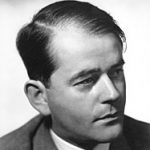
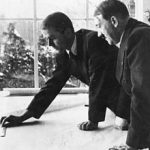 As the chief architect and minister for armaments and war production, Albert Speer designed many of the great buildings that Hitler craved. Hitler loved having the very best. Hitler was always impressed by academic credentials and any kind of artistic or technical talent, so he made Speer his personal architect. Albert Speer was born March 19, 1905, in Mannheim, Germany. At the age of 22, he received his architectural license, having studied at three German technical schools. He became an ardent Nazi after hearing Hitler speak at a rally in late 1930, and joined the party in January 1931. It was his decision to become a Nazi that gave him the opportunity to be noticed by Hitler.
As the chief architect and minister for armaments and war production, Albert Speer designed many of the great buildings that Hitler craved. Hitler loved having the very best. Hitler was always impressed by academic credentials and any kind of artistic or technical talent, so he made Speer his personal architect. Albert Speer was born March 19, 1905, in Mannheim, Germany. At the age of 22, he received his architectural license, having studied at three German technical schools. He became an ardent Nazi after hearing Hitler speak at a rally in late 1930, and joined the party in January 1931. It was his decision to become a Nazi that gave him the opportunity to be noticed by Hitler.
It was the fact that he now worked for Hitler, that gave him the power he craved for himself. Hitler began a massive Berlin building program. Among the projects the Fuhrer entrusted Speer with was the design of the parade grounds for the Nuremberg Party Congress in 1934, which Leni Riefienstahl made famous in her famous propaganda film Triumph of the Will. As minister of armaments and munitions, Speer’s job description expanded to include not only armament production and transportation, but also the direction of raw material use and finally the conscription of slave labor, culled from concentration camps, for war material production. On this day, November 21, 1941, Speer approached Hitler, and asked for 30,000 Soviet prisoners to be slave labor for his projects,telling Hitler that these slave laborers would come in handy for his “new” Berlin. Speer wanted to begin construction even as the war waged. Despite the drain on resources Hitler agreed. Speer beguiled the Fuhrer with models of a Great Hall for the Chancellery and a grand office for Goering. I find it strange to think that someone finally pulled a few things over on Hitler, who always seemed to have the upper hand.
The program was going well, but the times were not in Speer’s favor, or Hitler’s. The war turned against Nazi Germany, the rebuilding plans were scrapped. When the war was over, Hitler was dead by his own hand, and Speer was tried as a war criminal at Nuremberg, the site of his grand parade, and sentenced to 20 years in prison for his role in the Nazi regime, principally for the use of forced labor. Despite repeated attempts to gain early release, he served his full sentence, most of it at Spandau Prison in West Berlin. Following his release in 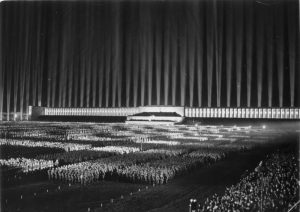
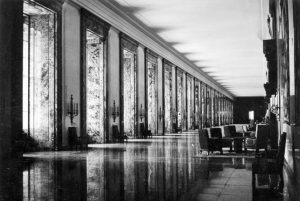 1966, Speer published two bestselling autobiographical works, Inside the Third Reich and Spandau: The Secret Diaries, detailing his close personal relationship with Hitler, and providing readers and historians with a unique perspective on the workings of the Nazi regime. He wrote a third book, Infiltration, about the SS. Speer died of a stroke in 1981 while on a visit to London.
1966, Speer published two bestselling autobiographical works, Inside the Third Reich and Spandau: The Secret Diaries, detailing his close personal relationship with Hitler, and providing readers and historians with a unique perspective on the workings of the Nazi regime. He wrote a third book, Infiltration, about the SS. Speer died of a stroke in 1981 while on a visit to London.
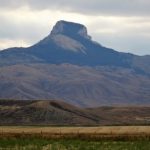
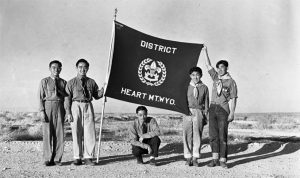 In the middle of a war, the people of a nation become concerned about anyone who might potentially be the enemy, especially if they are living inside the country’s borders. It is really a natural reaction to enemy personnel. After the Japanese attacked Pearl Harbor, the United states became quite concerned about the Japanese immigrants in our country, whether they were here legally or not. Much of the immigration to the United States from Japan began in 1884, when thousands of Japanese arrived in Hawaii to work the sugar cane fields. In the wake of the 1882 Chinese Exclusion Act, which drastically restricted Chinese immigration, Japanese people began arriving and began to prosper and started small businesses or became farmers. Most of them settled along the West Coast, meaning roughly 13,000 people of Japanese descent lived in the Intermountain West prior to World War II. The attack on Pearl Harbor, heightened the level of concern about those people.
In the middle of a war, the people of a nation become concerned about anyone who might potentially be the enemy, especially if they are living inside the country’s borders. It is really a natural reaction to enemy personnel. After the Japanese attacked Pearl Harbor, the United states became quite concerned about the Japanese immigrants in our country, whether they were here legally or not. Much of the immigration to the United States from Japan began in 1884, when thousands of Japanese arrived in Hawaii to work the sugar cane fields. In the wake of the 1882 Chinese Exclusion Act, which drastically restricted Chinese immigration, Japanese people began arriving and began to prosper and started small businesses or became farmers. Most of them settled along the West Coast, meaning roughly 13,000 people of Japanese descent lived in the Intermountain West prior to World War II. The attack on Pearl Harbor, heightened the level of concern about those people.
It was decided that, because their loyalties could not positively be confirmed, the Japanese immigrants needed to be rounded up and put in concentration camps. I suppose this might have seemed similar to what the Germans did to the Jewish people, but the Japanese people were not murdered in the camps, like the Jews were. And so it came to be that the people of Japanese descent from Oregon, Washington and California were incarcerated at the Heart Mountain Relocation Center in Park County, Wyoming, by the executive order of President Franklin Roosevelt. The prisoners were held at the camp from August 12, 1942 to November 10, 1945, which was actually two months after the end of the war with Japan. The camp was populated with 10,000 people at its largest, making it the third largest town in the state at the time.
I have tried to imagine what it must have been like for those Japanese immigrants to be held in the Heart Mountain Relocation Center for as much as 2 years and 3 months. Of course, the illegal immigrants of our time immediately came to my mind, but there is a difference between these people and the illegal immigrants of today. These people were here legally, and most of them had already become citizens. Unfortunately, that did not calm the worried minds of the rest of the people of the United States. Our nation had been attacked, and the attackers looked just like the Japanese immigrants. Precautions had to be taken. I’d like to think that if it were me, in that position, that I would understand why this was happening, but I’m not so sure I would. After all, these people were not criminals. They were hard working Americans, and yet they were for a time…the enemy, or possibly the enemy.
Unfortunately, like many prior immigrant groups, the Japanese faced discrimination. Things aren’t always fair, and people aren’t always treated properly. Starting in the early 20th century, Japanese immigrants, as well as Chinese immigrants, were targeted by Alien Land Laws in western states including Wyoming. These laws prevented the Asian immigrants from buying land. In 1924, the United States Congress passed the Asian Exclusion Act, which all but cut off new immigration from Asia. In response, Japanese Americans formed organizations such as the Japanese American Citizens’ League to help address their shared challenges. Despite 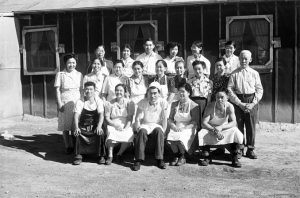 the attempts of Japanese Americans to fit in, some people expressed ongoing skepticism regarding the place of Asians in American society.
the attempts of Japanese Americans to fit in, some people expressed ongoing skepticism regarding the place of Asians in American society.
The Heart Mountain facility consisted of 450 barracks, each containing six apartments, when the first internees arrived on August 12, 1942. The largest apartments were simply single rooms measuring 24 feet by 20 feet. The barracks were covered with tar paper. While each unit was eventually outfitted with a potbellied stove, none had bathrooms. The people all used shared latrines. None of the apartments had kitchens. The residents ate their meals in mess halls. When the people first arrived, a barbed-wire fence to surround the camp was not yet complete. The internees protested the construction of this barrier and caused further work to be delayed. In November 1942, they submitted a petition containing 3,000 signatures to the War Relocation Authority (WRA) Director Dillon Meyer. The fence was completed by December, however, and further emphasized the sense of confinement among the internees. Shortly after the construction of the fence, 32 boys were arrested for sledding in the hills beyond the boundary. In response to the perceived overreaction on the part of the camp administration, Rikio Tomo, a Heart Mountain internee, placed an editorial in the Heart Mountain Sentinel asking for clarification about the internees’ citizenship status and constitutional freedoms. Schools were built at Heart Mountain, including a high school, to accommodate the children. These schools served students from elementary school through high school. Roughly 1500 students attended Heart Mountain High School, which included grades 8-12.
The internees provided most of the labor required to run the Heart Mountain camp, while WRA administrators oversaw its general operations. Wages ranged from $12 per month for unskilled labor to $19 per month for skilled labor, including teachers for the schools and doctors in the camp hospitals. In addition, Heart Mountain internees also worked as manual laborers on farms and ranches in Wyoming and nearby states from Nebraska to Oregon. The WRA administrators encouraged activities emphasizing American civics, such as scouting and adult English classes, as part of what they saw as an Americanization process. Committees composed initially of American-born internees provided much of the day-to-day governance of the camps. While these groups provided some measure of self-determination, they disrupted the generational hierarchy. American-born adults in their 20s and 30s were given a higher political status within the camps than their Japanese-born parents.
In 1943, General George Marshall approved the creation of the Japanese-American combat unit. As a result of the low turnout, the War Department extended the draft to the camps. It was decided that while they were not free to go where they chose, these people were needed to serve their country, so a draft was instituted. After they were drafted into the U.S. Army, soldiers from Heart Mountain occasionally returned to visit their families who were still held there. Somehow that doesn’t seem quite fair to me, and many of the prisoners agreed. They thought they should have been given their constitutional rights back before they were drafted. The organization of draft resistance distinguished Heart Mountain from the other relocation centers. The plan, which was given the endorsement of President Roosevelt, was to create an all-Japanese regiment, consisting of soldiers from a previously existing Hawaiian unit and volunteers from the camps. The response from within the camps fell far short of expectations, partly because of a loyalty questionnaire distributed by the WRA. The WRA form was used to determine eligibility for military service and permanent leave. Many of the questions were considered intrusive by prisoners. Others were not as straightforward as the WRA probably intended. Instead of serving as a neutral tool to determine someone’s suitability for service, the questionnaire further alienated many the men. To me it seems that the WRA was somehow not aware of how racist the entire situation really was. For example, question 27 asked about a person’s willingness to serve in the military. For 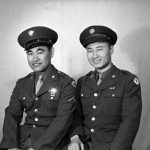
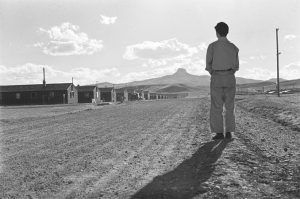 prisoners who felt service should be contingent upon the restoration of constitutional rights to all Japanese Americans, a simple yes or no answer was insufficient. In each of the camps, the draft became a divisive issue. While some prisoners felt military service was an opportunity to exemplify patriotism, others felt that constitutional rights should be restored before agreeing to mandatory service. I doubt if the situation would have ever really been resolved, except that the war ended.
prisoners who felt service should be contingent upon the restoration of constitutional rights to all Japanese Americans, a simple yes or no answer was insufficient. In each of the camps, the draft became a divisive issue. While some prisoners felt military service was an opportunity to exemplify patriotism, others felt that constitutional rights should be restored before agreeing to mandatory service. I doubt if the situation would have ever really been resolved, except that the war ended.
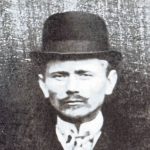
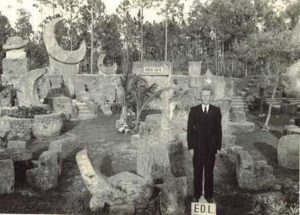 Edward Leedskalnin was a bit of an eccentric, which might have been caused by the sadness of lost love. When Edward was suddenly rejected by his 16 year old fiancée Agnes Skuvst in Latvia, just one day before the wedding, he decided to immigrate to America. Once there, he came down with allegedly terminal tuberculosis, but was spontaneously healed. He believed that magnets had some effect on his disease. I don’t know about that part, but he lived much longer that he was ever expected to.
Edward Leedskalnin was a bit of an eccentric, which might have been caused by the sadness of lost love. When Edward was suddenly rejected by his 16 year old fiancée Agnes Skuvst in Latvia, just one day before the wedding, he decided to immigrate to America. Once there, he came down with allegedly terminal tuberculosis, but was spontaneously healed. He believed that magnets had some effect on his disease. I don’t know about that part, but he lived much longer that he was ever expected to.
Leedskalnin decided to build himself a home where he could live out his years in solitude. The resulting “home” was eventually names Coral Castle, but was originally named “Ed’s Place.” Leedskalnin originally built the castle in Florida City, Florida, around 1923. Florida City, which borders the Everglades, is the southernmost city in the United States that is not on an island. It was an extremely remote location with very little development at the time. Leedskalnin built the castle by himself, out of Oolite Limestone. Edward spent more than 28 years building Coral Castle, refusing to allow anyone to view him while he worked. A few teenagers claimed to have watched his work a few times and reported that he had caused the blocks of coral to move like hydrogen balloons. The only tool that Leedskalnin spoke of using was a “perpetual motion holder”. The stones are fastened together without mortar. They are set on top of each other using their weight to keep them together. The craftsmanship detail is so skillful and the stones are connected with such precision that no light passes through the joints. The 8-foot tall vertical stones that make up the perimeter wall have a uniform height. Even with the passage of decades the stones have not shifted.
Leedskalnin purchased the land from Ruben Moser whose wife had assisted him when he had a very bad bout with tuberculosis. The castle remained in Florida City until about 1936 when Leedskalnin decided to move and take the castle with him. He renamed it “Rock Gate.” The move was an even more amazing feat the the first building of the castle. Its second and final location has the mailing address of 28655 South Dixie Highway, Miami, FL 33033, which now appears within Leisure City but which is actually unincorporated county territory. He reportedly chose relocation as a means to protect his privacy when discussion about developing land in the original area of the castle started. He spent three years moving the component structures of Coral Castle 10 miles north of Florida City to its current location outside Homestead, Florida.
At Florida City, Leedskalnin allowed visitors to the castle, charging them ten cents apiece to tour the castle grounds, but after moving to Homestead, he asked for donations of twenty five cents. Nevertheless, he let visitors enter free if they had no money. There are signs carved into rocks at the front gate to “Ring Bell Twice.” He would come down from his living quarters in the second story of the castle tower close to the gate and conduct the tour. Leedskalnin never told anyone who asked him how he made the castle. He would simply answer “It’s not difficult if you know how.” When Leedskalnin became ill in November 1951, he put a sign on the door of the front gate “Going to the Hospital” and took the bus to Jackson Memorial Hospital in Miami. Leedskalnin suffered a stroke at one point, either before he left for the hospital or at the hospital. He died twenty-eight days later of Pyelonephritis (a kidney infection) at the age of 64. His death certificate noted that his death was a result of “uremia; failure of kidneys, as a result of the infection and abscess.” While the property was being investigated, $3,500 was found among Leedskalnin’s personal belongings. Leedskalnin had made his income from conducting tours, selling pamphlets about various subjects (including magnetic currents) and the sale of a portion of his 10-acre property for the construction of U.S. Route 1. As Leedskalnin had no will, the castle became the property of his closest living relative in America, a nephew from Michigan named Harry. Coral Castle’s website reports that the nephew was in poor health and he sold the castle to an Illinois family in 1953. However, this story differs from the obituary of a former Coral Castle owner, Julius 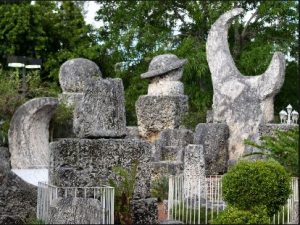
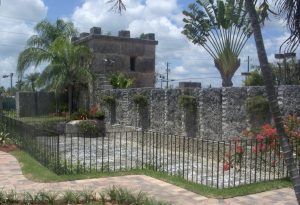 Levin, a retired jeweler from Chicago, Illinois. The obituary states Levin had purchased the land from the state of Florida in 1952 and may not have been aware there was even a castle on the land. The new owners turned it into a tourist attraction and changed the name of Rock Gate to Rock Gate Park, and later to Coral Castle. In January 1981, Levin sold the castle to Coral Castle, Inc., for $175,000. The company retains ownership today.
Levin, a retired jeweler from Chicago, Illinois. The obituary states Levin had purchased the land from the state of Florida in 1952 and may not have been aware there was even a castle on the land. The new owners turned it into a tourist attraction and changed the name of Rock Gate to Rock Gate Park, and later to Coral Castle. In January 1981, Levin sold the castle to Coral Castle, Inc., for $175,000. The company retains ownership today.
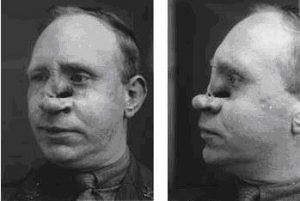 When people think of plastic surgery, the mind congers up images of everything from severe scar repair to vanity surgeries, but who originally came up with these procedures. Although the development of plastic surgery is popularly believed to have taken place in modern times, the origins of plastic surgery are very old. In the early part of the 1400s, the nose received the most attention from the early plastic surgeons. One of the first procedures for reconstructing the nose, a primitive precursor to the nose job, is attributed to a surgeon called Antonio Branca.
When people think of plastic surgery, the mind congers up images of everything from severe scar repair to vanity surgeries, but who originally came up with these procedures. Although the development of plastic surgery is popularly believed to have taken place in modern times, the origins of plastic surgery are very old. In the early part of the 1400s, the nose received the most attention from the early plastic surgeons. One of the first procedures for reconstructing the nose, a primitive precursor to the nose job, is attributed to a surgeon called Antonio Branca.
After that era, Plastic surgery had to wait until the late 18th century for the next significant advance in its history…the skin graft. And ironically the breakthrough came from rediscovering a procedure developed in ancient India. The severe-looking skin graft procedure was rediscovered in an ancient book called the “Sushruta Samhita,” dating back to 8th century BC. There hidden in the book’s 184 chapters was a technique using a leaf-shaped flap from the forehead to 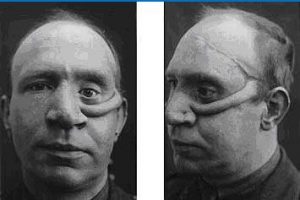 reconstruct the nose. The technique was published in the ‘Gentleman’s Magazine of Calcutta’ in October 1794 and it soon became widely used. It was known as the “Indian Method”.
reconstruct the nose. The technique was published in the ‘Gentleman’s Magazine of Calcutta’ in October 1794 and it soon became widely used. It was known as the “Indian Method”.
While these methods undoubtedly had a great impact on the history of plastic surgery, it would be another event that would have one of the biggest impacts on plastic surgery, and its methodology. That event was World War I. Shrapnel was the cause of many facial injuries during world War I, and unlike the straight-line wounds inflicted by bullets, the twisted metal shards produced from a shrapnel blast could easily rip a face off. Harold Gillies, a surgeon, was horrified by the injuries he saw, and he immediately took on the task of helping these victims. He saw these men as more than victims. They were heroes, and that’s how he saw them. He knew he had to do something to help these men get back to a normal life. So, he pioneered early techniques of facial reconstruction in the process.
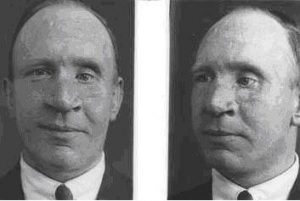 While these were great advances, it’s likely that the most significant improvements in the history of plastic surgery occurred in the last century. Several plastic surgery techniques were introduced during the world wars. Skin grafting techniques such as the “tubed pedicled graft,” were state of the art during World War I. Archibald McIndoe and Harold Gillies refined the techniques to treat severe facial burns. These staged procedures differed from earlier plastic surgery because they relied on the growth and development of a blood supply from the recipient bed into the grafted tissue over many weeks or months. While that all seems pretty normal these days, it was unheard of until then.
While these were great advances, it’s likely that the most significant improvements in the history of plastic surgery occurred in the last century. Several plastic surgery techniques were introduced during the world wars. Skin grafting techniques such as the “tubed pedicled graft,” were state of the art during World War I. Archibald McIndoe and Harold Gillies refined the techniques to treat severe facial burns. These staged procedures differed from earlier plastic surgery because they relied on the growth and development of a blood supply from the recipient bed into the grafted tissue over many weeks or months. While that all seems pretty normal these days, it was unheard of until then.
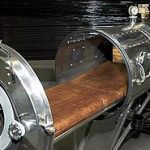 Called an Iron Lung, the negative pressure ventilator was a common tool used to treat polio when that disease was deadly and much feared. Poliomyelitis, which is often called polio or infantile paralysis, is an infectious disease caused by the poliovirus. In about 0.5 percent of cases there is muscle weakness resulting in an inability to move. This can occur over a few hours to a few days. The weakness most often involves the legs but may less commonly involve the muscles of the head, neck and diaphragm. Many people fully recover. In those with muscle weakness about 2 to 5 percent of children and 15 to 30 percent of adults die. Another 25 percent of people have minor symptoms such as fever and a sore throat and up to 5 percent have headache, neck stiffness and pains in the arms and legs. These people are usually back to normal within one or two weeks. In up to 70 percent of infections there are no symptoms. Years after recovery post-
Called an Iron Lung, the negative pressure ventilator was a common tool used to treat polio when that disease was deadly and much feared. Poliomyelitis, which is often called polio or infantile paralysis, is an infectious disease caused by the poliovirus. In about 0.5 percent of cases there is muscle weakness resulting in an inability to move. This can occur over a few hours to a few days. The weakness most often involves the legs but may less commonly involve the muscles of the head, neck and diaphragm. Many people fully recover. In those with muscle weakness about 2 to 5 percent of children and 15 to 30 percent of adults die. Another 25 percent of people have minor symptoms such as fever and a sore throat and up to 5 percent have headache, neck stiffness and pains in the arms and legs. These people are usually back to normal within one or two weeks. In up to 70 percent of infections there are no symptoms. Years after recovery post-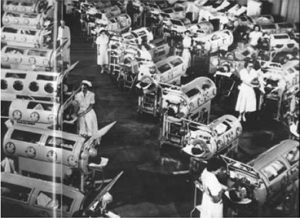 polio syndrome may occur, with a slow development of muscle weakness similar to that experienced during the initial infection. Polio is more common in infants and young children, occurring under conditions of poor hygiene.
polio syndrome may occur, with a slow development of muscle weakness similar to that experienced during the initial infection. Polio is more common in infants and young children, occurring under conditions of poor hygiene.
Because of complete or partial loss of muscle usage, people with polio had a difficult time breathing, which can cause a myriad of problems, including pneumonia. Enter the Emerson iron lung. The affected patient lies within the chamber, which when sealed provides an effectively oscillating atmospheric pressure. A negative pressure ventilator, or iron lung, is a nearly-obsolete mechanical respirator which enables a person to breathe on their own in a normal manner, when muscle control is lost, or the work of breathing exceeds the person’s ability, as may result from certain diseases. Polio was not the only disease that called for the iron lung. In addition to 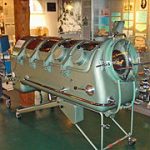 Polio, botulism and certain poisons, such as barbiturates, tubocurarine, also benefited from its use.
Polio, botulism and certain poisons, such as barbiturates, tubocurarine, also benefited from its use.
Versions of the Iron Lung include both the Drinker respirator, the Emerson respirator, and the Both (Emerson-Drinker) respirator. The negative form of pressure ventilation…decreasing surrounding pressure to induce inhalation then re-pressurizing to 1 bar (15 psi; 750 mmHg)…has been almost entirely superseded by positive pressure ventilation (forcing air into the lungs with a pressure greater than 1 bar then allowing the body to naturally exhale before repeating) or negative pressure cuirass ventilation. While the iron lung is not used anymore, it served a useful purpose in its day.
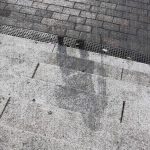 When I think of people disappearing, my Christian mind automatically envisions the rapture of the church, but there have, of course, been other times when people have disappeared, and some of them were utterly horrifying. One such horrifying version of people disappearing is the nuclear bombings of Hiroshima and Nagasaki. I have never been able to wrap my head around my feelings about the Atomic Bombs that were dropped on August 6 and August 9, 1945, respectively. Though we were at war, the Atomic Bomb seemed such an extreme weapon. Nevertheless, it was what was used those days to show that we meant business.
When I think of people disappearing, my Christian mind automatically envisions the rapture of the church, but there have, of course, been other times when people have disappeared, and some of them were utterly horrifying. One such horrifying version of people disappearing is the nuclear bombings of Hiroshima and Nagasaki. I have never been able to wrap my head around my feelings about the Atomic Bombs that were dropped on August 6 and August 9, 1945, respectively. Though we were at war, the Atomic Bomb seemed such an extreme weapon. Nevertheless, it was what was used those days to show that we meant business.
On August 6th, one of its B-29s dropped a Little Boy uranium gun-type bomb on Hiroshima. Three days later, on August 9th, a Fat Man plutonium implosion-type bomb was dropped by another B-29 on Nagasaki. The bombs immediately devastated their targets. Over the next two to four months, the acute effects of the atomic bombings killed 90,000–146,000 people in Hiroshima and 39,000–80,000 people in Nagasaki…roughly half of the deaths in each city occurred on the first day. Large numbers of people continued to die from the effects of burns, radiation sickness, and other injuries, compounded by illness and malnutrition, for many months afterward. In both cities, most of the dead were civilians, although Hiroshima had a sizable military garrison. While the bombings were met with mixed feelings worldwide, the plan worked. Just six days later, on August 15, 1945, Japan announced its surrender.
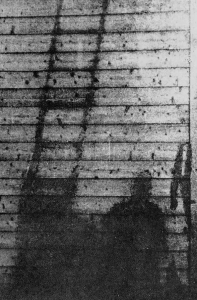
The atomic bombs were successful, but as I said, my feelings were similar to the rest of the world’s feelings. The devastation from the bombs was unbelievable. Those who survived the initial attack died a slow death, and in reality that was the worse way to go. Those who were killed instantly, were in reality obliterated…they simply disappeared. As shocking as that was to me, what I found even more shocking was what was left behind. The atomic bombs basically burned a picture of the victims onto whatever was near them…a wall, stairs, or the side of a building. That was difficult to wrap my head around. When I saw a nuclear shadow of a child playing jump rope that was flashed against the side of a building, my thoughts immediately went to the fact that this child had no idea that his life was about to be over. I don’t suppose there was time for him to feel any pain, and that was probably the most merciful part of the entire horrible event.
The nuclear shadows were everywhere, preserved as vivid reminders of what had taken place. For as long as ten years, the shadows were still there. Then they started to fade. As buildings were remodeled, some of the shadows were removed at preserved in the Hiroshima Peace Memorial Museum. One shadow, thought to be the outline of a person who was sitting at the entrance of Hiroshima Branch of Sumitomo Bank when the atomic bomb was dropped over Hiroshima, is known as Human Shadow of Death. According to the museum, “it is thought that the person had been sitting on the stone step waiting for the bank to open when the heat from the bomb burned the surrounding stone white and left their shadow. A black deposit was also found on the shadow. 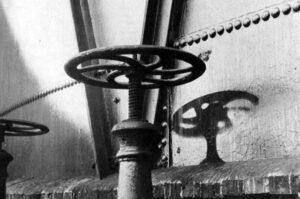 A piece of stone containing the artifact was cut from the original location and moved to the museum.” Also, according to museum staff, “many visitors to the museum believe that the shadow is the outline of a human vaporized immediately after the bombing. However, the possibility of human vaporization is not supported from a medical perspective. The ground surface temperature is thought to have ranged from 3,000 to 4,000 degrees Celsius just after the bombing. Exposing a body to this level of radiant heat would leave bones and carbonized organs behind. While radiation could severely inflame and ulcerate the skin, complete vaporization of the body is impossible.” Nevertheless, it appears to have happened, whether they believe it or not.
A piece of stone containing the artifact was cut from the original location and moved to the museum.” Also, according to museum staff, “many visitors to the museum believe that the shadow is the outline of a human vaporized immediately after the bombing. However, the possibility of human vaporization is not supported from a medical perspective. The ground surface temperature is thought to have ranged from 3,000 to 4,000 degrees Celsius just after the bombing. Exposing a body to this level of radiant heat would leave bones and carbonized organs behind. While radiation could severely inflame and ulcerate the skin, complete vaporization of the body is impossible.” Nevertheless, it appears to have happened, whether they believe it or not.
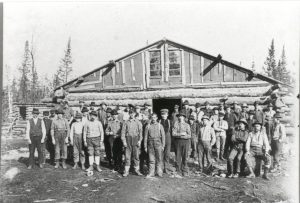
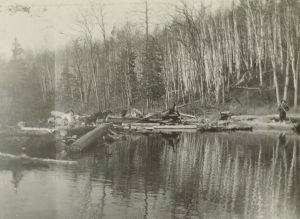 Established as a national forest in 1909, Superior National Forest is located in far northern Minnesota. Big pine timber logging began in the Superior National Forest in the 1890s and continued into the 1920s. Logging was not easy in Superior National Forest, and much of the area remained untouched because of the border lakes region, which presented numerous challenges to the logging companies in accessing and harvesting the stands of timber. In the 1890s, vast extents of the border lakes forests had been stripped away in Michigan and Wisconsin. The early logging was accomplished by means of river driving of logs. That was one of the types of logging that my grandfather was involved in. The logs were cut down,and then floated down the river to the saw mills. The method was a good one, but it could also be dangerous. Many a man was pinched between the logs, and many died. I’m very thankful my grandfather, Allen Luther Spencer was not one of those poor men who lost their lives doing this job. As timber near rivers became depleted, railroad logging became the primary method of getting the wood to the mill. Frozen ground conditions in the winter steered the logging industry to build ice roads providing greater access to timber stands. Logging after 1929 focused more and more on pulp species and the wood products industry.
Established as a national forest in 1909, Superior National Forest is located in far northern Minnesota. Big pine timber logging began in the Superior National Forest in the 1890s and continued into the 1920s. Logging was not easy in Superior National Forest, and much of the area remained untouched because of the border lakes region, which presented numerous challenges to the logging companies in accessing and harvesting the stands of timber. In the 1890s, vast extents of the border lakes forests had been stripped away in Michigan and Wisconsin. The early logging was accomplished by means of river driving of logs. That was one of the types of logging that my grandfather was involved in. The logs were cut down,and then floated down the river to the saw mills. The method was a good one, but it could also be dangerous. Many a man was pinched between the logs, and many died. I’m very thankful my grandfather, Allen Luther Spencer was not one of those poor men who lost their lives doing this job. As timber near rivers became depleted, railroad logging became the primary method of getting the wood to the mill. Frozen ground conditions in the winter steered the logging industry to build ice roads providing greater access to timber stands. Logging after 1929 focused more and more on pulp species and the wood products industry.
Soon, it became evident that the logging industry, while a good a profitable industry, had the potential to deplete the natural resources in the Superior National Forest. In 1921, Arthur Carhart (Forest Landscape Architect) published “Preliminary Prospectus: An Outline Plan for the Recreational Development of the Superior National Forest.” It was released following a survey conducted by Carhart and Forest Guard Soderback in the Boundary Waters region. This publication began to set the framework for the future designation of the BWCAW.
In 1930, Shipstead-Newton-Nolan Act was passed placing restrictions aimed at preserving the wilderness nature of lake and stream shorelines. By 1934, President Franklin D. Roosevelt designated the Quetico-Superior Committee to work with government agencies in the conservation, preservation, and use of northeast Minnesota’s wilderness areas. 1948 brought the Thye-Blatnik Act authorized the federal government to acquire private land holdings within roadless areas, thereby increasing federal acreage within the boundary waters roadless area. In 1949, the passage of Executive Order #10092, established an airspace boundary over the boundary waters roadless area. Highly controversial, this order effectively ended a particular type of recreation in the boundary waters, that of the remote fly-in resort. Resort operators had until 1951 to halt air traffic within 4000 feet of the roadless area.In 1958, The Superior Roadless Areas were renamed the Boundary Waters Canoe Area (BWCA). Conflict over motorized use in the roadless area increased during this time. The passage of the national Wilderness Act in 1964, with special provision regarding the BWCA, allowed some motorized use 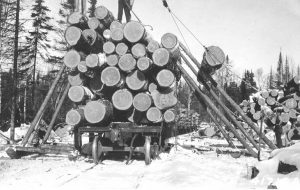
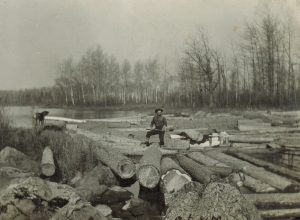 and logging within the Boundary Water’s wilderness boundaries, but by 1978, with the passage of the Boundary Waters Canoe Area Wilderness Act, which was specific to the BWCAW. This legislation eliminated logging and snowmobiling, restricted mining and allowed motorboats on 1/4 of the water area. While logging is necessary, I can’t help but agree with the preservation of the beautiful Superior National Forest.
and logging within the Boundary Water’s wilderness boundaries, but by 1978, with the passage of the Boundary Waters Canoe Area Wilderness Act, which was specific to the BWCAW. This legislation eliminated logging and snowmobiling, restricted mining and allowed motorboats on 1/4 of the water area. While logging is necessary, I can’t help but agree with the preservation of the beautiful Superior National Forest.
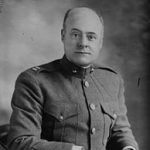 Anthony Joseph Drexel Biddle I (1874–1948) was an eccentric millionaire whose fortune allowed him to pursue theatricals, self-published writing, athletics, and Christianity on a full-time basis. He was the man upon whom the book “My Philadelphia Father” and the play and film “The Happiest Millionaire” were based, but even before that Biddle was eccentric…to say the least. Biddle was a trainer in hand-to-hand combat in both World War I and World War II. In fact, Biddle was an expert in hand-to-hand combat. He also had an unusual way of training his men. It was not unusual for Biddle to tell his trainees to attempt to kill him!! I can’t say for sure that he allowed them to use live ammunition, but he did give them “chance” to try to kill him before he could disarm them.
Anthony Joseph Drexel Biddle I (1874–1948) was an eccentric millionaire whose fortune allowed him to pursue theatricals, self-published writing, athletics, and Christianity on a full-time basis. He was the man upon whom the book “My Philadelphia Father” and the play and film “The Happiest Millionaire” were based, but even before that Biddle was eccentric…to say the least. Biddle was a trainer in hand-to-hand combat in both World War I and World War II. In fact, Biddle was an expert in hand-to-hand combat. He also had an unusual way of training his men. It was not unusual for Biddle to tell his trainees to attempt to kill him!! I can’t say for sure that he allowed them to use live ammunition, but he did give them “chance” to try to kill him before he could disarm them.
An officer in the United States Marine Corps, Biddle was an expert in close-quarters fighting and the author of “Do or Die: A Supplementary Manual on Individual Combat,” a book on combat methods, including knives and empty-hand skills, training both the United States Marine Corps in two world wars and Special Agents of the Federal Bureau of Investigation. He was considered not just an expert in fighting, but also a pioneer of United States Marine Corps training in the bayonet and hand-to-hand combat. He based his style on fencing, though this approach was sometimes criticized as being unrealistic for military combat. At one point, when it looked like there was no way out of a drill he assigned to his men…they were surrounding him, and for all intents and 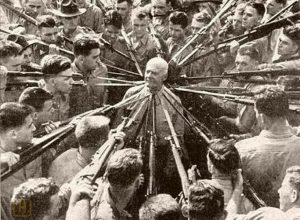 purposes, they had him. Nevertheless, the outcome was not what anyone would have expected, because within in a few minutes, Biddle had completely disarmed each and every one of the men.
purposes, they had him. Nevertheless, the outcome was not what anyone would have expected, because within in a few minutes, Biddle had completely disarmed each and every one of the men.
Born on October 1, 1874 in Philadelphia, Pennsylvania, to Edward Biddle II and Emily Drexel, Anthony was grandson of banker Anthony Joseph Drexel, and great-grandson of banker Nicholas Biddle. Biddle was a graduate of Germany’s Heidelberg University. He was a fellow of the American Geographical Society and founded a movement called “Athletic Christianity” that eventually attracted 300,000 members around the world. A 1955 Sports Illustrated article called him “boxing’s greatest amateur” as well as a “major factor in the re-establishment of boxing as a legal and, at that time, estimable sport.” He joined the Marines in 1917 at the age of 41, and convinced his superiors to include boxing in Marine Corps recruit training. In 1919, he was promoted to the rank of major, and became a lieutenant colonel in 1934. In Lansdowne, Pennsylvania, right outside of Philadelphia, Biddle opened a military training facility, where he trained 4,000 men. His training included long hours of calisthenics and gymnastics, and taught skills such as machete, saber, dagger, bayonet combat, hand grenade use, boxing, wrestling, savate and jiujitsu. He also served two years in the National Guard.
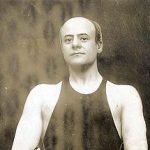 In 1895, he married Cordelia Rundell Bradley. Their marriage was blessed with three children, Anthony Joseph Drexel Biddle Jr. (1897–1961), who married Mary Duke (1887–1960). They were the parents of Mary Duke Biddle (1920–2012) and Nicholas Benjamin Duke Biddle. Their second child was Cordelia Drexel Biddle (1898–1984), who married Angier Buchanan Duke (1884–1923), the son of Benjamin Newton Duke. They were the parents of Angier Biddle Duke (1915–1995) and Anthony Drexel Duke (1918-2014). Their third child was Livingston Ludlow Biddle (1899–1981), who married Kate Raboteau Page (b. 1903), daughter of Robert N. Page. They were the parents of Livingston Ludlow Biddle III. Biddle died May 27, 1948 from a cerebral hemorrhage and uremic poisoning.
In 1895, he married Cordelia Rundell Bradley. Their marriage was blessed with three children, Anthony Joseph Drexel Biddle Jr. (1897–1961), who married Mary Duke (1887–1960). They were the parents of Mary Duke Biddle (1920–2012) and Nicholas Benjamin Duke Biddle. Their second child was Cordelia Drexel Biddle (1898–1984), who married Angier Buchanan Duke (1884–1923), the son of Benjamin Newton Duke. They were the parents of Angier Biddle Duke (1915–1995) and Anthony Drexel Duke (1918-2014). Their third child was Livingston Ludlow Biddle (1899–1981), who married Kate Raboteau Page (b. 1903), daughter of Robert N. Page. They were the parents of Livingston Ludlow Biddle III. Biddle died May 27, 1948 from a cerebral hemorrhage and uremic poisoning.
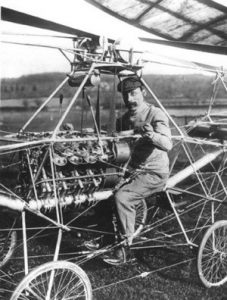 After the Wright brothers discovered a way to make a plane fly, all bets were off as to where the future would take us. It didn’t take very long to find out either. By 1907, a man named Paul Cornu came up with an entirely different type of aircraft, and built the Cornu Helicopter. As most of us know these days, the helicopter is a rotary-wing aircraft that creates its own lift. The Cornu helicopter was an experimental helicopter that was built in France. The craft had an open framework, that obviously didn’t provide much protection from the elements, and so was somewhat limited in when it could fly, but then there are still times when a helicopter can’t fly, so I guess that not much has changed in that respect.
After the Wright brothers discovered a way to make a plane fly, all bets were off as to where the future would take us. It didn’t take very long to find out either. By 1907, a man named Paul Cornu came up with an entirely different type of aircraft, and built the Cornu Helicopter. As most of us know these days, the helicopter is a rotary-wing aircraft that creates its own lift. The Cornu helicopter was an experimental helicopter that was built in France. The craft had an open framework, that obviously didn’t provide much protection from the elements, and so was somewhat limited in when it could fly, but then there are still times when a helicopter can’t fly, so I guess that not much has changed in that respect.
Cornu was a bicycle maker, and so he built his craft around a curved steel tube that carried a rotor at either end, and the engine and pilot in the middle. Power was transmitted to the rotors by a drive belt that linked both rotors and spun them in opposite directions. Control was to be provided by cables that could alter the pitch of the rotor blades, and by steerable vanes at either end of the machine intended to direct the down wash of the rotors. On November 13, 1907, the helicopter was ready for its test flight. The Cornu helicopter is reported to have made a number of short hops, rising perhaps 5–7 feet into the air and staying aloft for something less than one minute…just long enough for Cornu to learn that the control systems he had designed were ineffective. He abandoned the machine soon thereafter. I find it sad to think that, while the design wasn’t going to work in it’s present form, it was certainly not something to give upon. I’m reminded of the old saying, “If at first you don’t succeed…try, try again.” Perhaps, if Paul Cornu had kept trying, he could have succeeded.
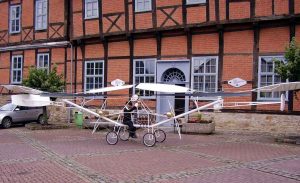 Modern engineering analyses have demonstrated that the Cornu helicopter could not have been capable of sustained flight. The design was flawed, nevertheless, in order to commemorate the centenary of his achievement, a replica of the helicopter was constructed by the École supérieure des techniques aéronautiques et de construction automobile (ESTACA) and presented to the Musée de l’Air et de l’Espace where it was placed on display on December 15, 2007. Another replica was also built. This one by the Hubschraubermuseum Bückeburg (Helicopter Museum of Bückeburg) to pay homage to the merits of Paul Cornu. It has been on display there since November 13, 2007. Though its fight was short, it did fly, after all.
Modern engineering analyses have demonstrated that the Cornu helicopter could not have been capable of sustained flight. The design was flawed, nevertheless, in order to commemorate the centenary of his achievement, a replica of the helicopter was constructed by the École supérieure des techniques aéronautiques et de construction automobile (ESTACA) and presented to the Musée de l’Air et de l’Espace where it was placed on display on December 15, 2007. Another replica was also built. This one by the Hubschraubermuseum Bückeburg (Helicopter Museum of Bückeburg) to pay homage to the merits of Paul Cornu. It has been on display there since November 13, 2007. Though its fight was short, it did fly, after all.

